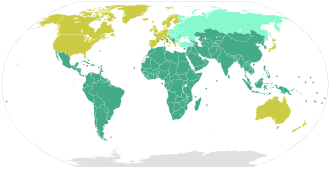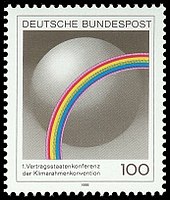United Nations Framework Convention on Climate Change
The United Nations Framework Convention on Climate Change (UNFCCC) is an international environmental agreement with the aim of preventing dangerous anthropogenic interference with the climate system and slowing down global warming and mitigating its consequences (Article 2). At the same time, this designation also includes the Secretariat, which oversees the implementation of the Convention and is based in Bonn. The most important obligation of the convention is that all contracting parties have to publish regular reports, so-called greenhouse gas inventories, which must include facts on current greenhouse gas emissions and trends.
The Framework Convention on Climate Change was adopted in New York City on 9 May 1992 and signed by 154 countries at the United Nations Conference on Environment and Development (UNCED) in Rio de Janeiro that same year. It entered into force two years later, on 21 March 1994. On 12 August 1996, the Secretariat of the Framework Convention on Climate Change moved to Haus Carstanjen in Bonn, and since autumn 2013 it has been based there and on the UN Campus in Bonn.
In order to avoid dangerous disruption of the climate system, greenhouse gas concentrations are to be stabilized. The increase in concentrations, until they are stabilized, should be slow enough to allow "ecosystems to adapt naturally to climate change, food production not to be threatened, and economic development to continue in a sustainable manner".
The most important principle is climate protection, which should serve present and future generations. The guiding principle of climate protection should be the common but differentiated responsibilities and respective capabilities of the member states (→ climate justice). Accordingly, the developed countries should take a leading role. The special needs, circumstances and burdens of developing countries are to be "fully taken into account" in the measures.
The obligations and rights of the contracting countries depend on whether and in which of the annexes to the Convention they are listed:
- Annex I: Annex I countries are essentially the then developed countries (OECD countries) and the former socialist countries in Eastern Europe ("countries in transition to a market economy"). Annex I countries have committed themselves to limiting greenhouse gas emissions and protecting carbon sinks with the aim of limiting climate change.
- Annex I and II: Only the OECD countries in Annex I belong to these countries. Countries in transition to a market economy are not included. Annex II states have committed themselves to special support services for developing countries. They assume the costs of reporting and are to promote developing countries' access to environmentally sound technologies.
- Non-Annex I: This includes all other states. These are mainly the countries that were considered developing countries at the time. Some groups of particularly vulnerable countries are given special consideration in the Convention, for example the least developed countries, small island countries or drought-prone countries.
The 197 parties to the convention meet annually for conferences, the UN climate conferences (also known as "world climate summits"), at which concrete measures for climate protection are discussed. The best-known conferences took place in 2015 (COP21, Paris), 2009 (COP15, Copenhagen) and 1997 (COP 3, Kyoto).
The Kyoto Conference adopted the Kyoto Protocol, which committed industrialized countries to quantitative greenhouse gas reduction targets and introduced International Emissions Trading and the project-based flexibility mechanisms Joint Implementation (JI) and the Clean Development Mechanism (CDM). The Copenhagen Conference was supposed to lead to a successor agreement to the Kyoto Protocol, which expires in 2012. However, all that was achieved was formal acceptance of the Copenhagen Accord, a non-legally binding declaration of intent on climate protection. The Paris Conference ended with the adoption of the Paris Agreement, which for the first time obliges all countries to define and implement reduction targets and to review progress. Every five years, the targets are to be compared with the latest scientific findings and adjusted.

Members of the UNFCCC Member Member (Annex I) Member (Annex I and II) Observer status

German special issue stamp 1995
Secretaries General of the Secretariat
- 1991-2002: Michael Zammit Cutajar
- 2002-2005: Joke Waller-Hunter
- 2006-2010: Yvo de Boer
- 2010-2016: Christiana Figueres
- since 2016: Patricia Espinosa
See also
- List of international environmental agreements
- National Climate Protection Programme
Search within the encyclopedia